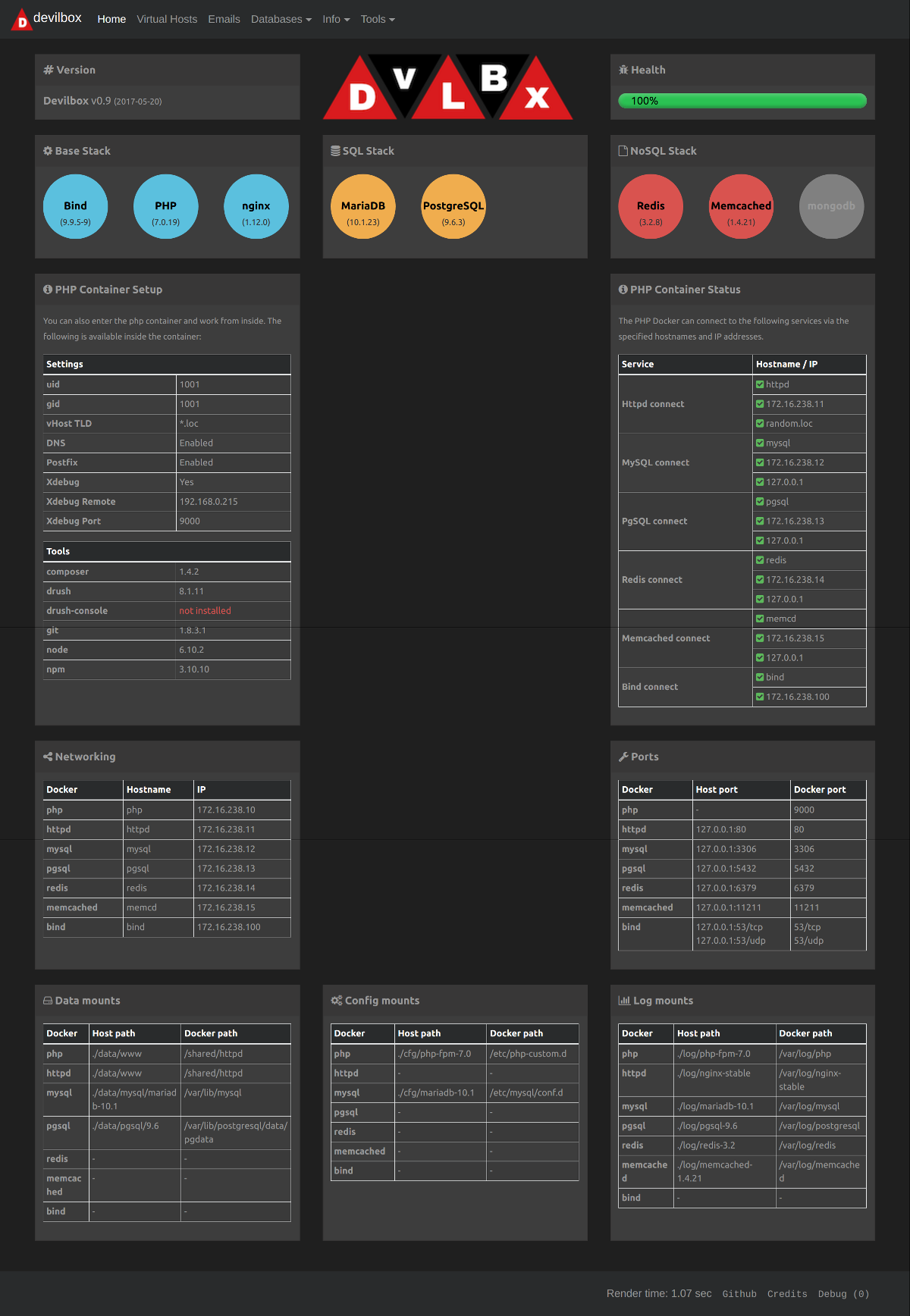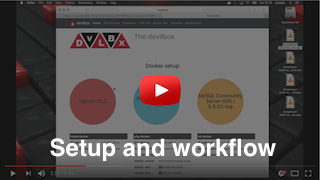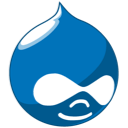Usage | Features | Documentation | Intranet | Screenshots | Contributing | Logos | License
The devilbox is a modern and highly customisable dockerized PHP stack supporting full LAMP and MEAN and running on all major platforms. The main goal is to easily switch and combine any version required for local development. It supports an unlimited number of projects for which vhosts and DNS records are created automatically. Email catch-all and popular development tools will be at your service as well. Configuration is not necessary, as everything is pre-setup with mass virtual hosting.
You are up and running in four simple steps:
# Get the devilbox
$ git clone https://github.com/cytopia/devilbox
$ cd devilbox
# Create docker-compose environment file
$ cp env-example .env
# Edit your configuration
$ vim .env
# Start all containers
$ docker-compose upThe above will start all containers, you can however also just start the containers you actually need. This is achieved by simply specifying them in the docker-compose command.
$ docker-compose up httpd php mysql redisEvery single attachable container comes with many different versions. In order to select the desired version for a container, simply edit the .env file and uncomment the version of choice. Any combination is possible.
| Apache | Nginx | PHP | MySQL | MariaDB | Percona | PgSQL | Redis | Memcached | MongoDB |
|---|---|---|---|---|---|---|---|---|---|
| 2.2 | stable | 5.4 | 5.5 | 5.5 | 5.5 | 9.1 | 2.8 | 1.4.21 | 2.8 |
| 2.4 | mainline | 5.5 | 5.6 | 10.0 | 5.6 | 9.2 | 3.0 | 1.4.22 | 3.0 |
| 5.6 | 5.7 | 10.1 | 5.7 | 9.3 | 3.2 | 1.4.23 | 3.2 | ||
| 7.0 | 8.0 | 10.2 | 9.4 | 4.0 | 1.4.24 | 3.4 | |||
| 7.1 | 10.3 | 9.5 | ... | 3.5 | |||||
| 7.2 | 9.6 | 1.5.2 | |||||||
| HHVM | 10.0 | latest |
You can also work directly inside the php container. Simply use the bundled scripts shell.sh. The PS1 will automatically be populated with current chosen php version.
# Enter as user devilbox (normal operation / development)
host> ./shell.sh
devilbox@php-7.0.19 in /shared/httpd $# Enter as root user (do root stuff)
host> ./shell.sh
devilbox@php-7.0.19 in /shared/httpd $ sudo su -
root@php-7.0.19 in /shared/httpd $Your projects can be found in /shared/httpd. DNS records are automatically available inside the php container. Also every other service will be available on 127.0.0.1 inside the php container (tricky socat port-forwarding).
The devilbox has everything setup for you. The only thing you will have to install is docker and docker-compose. Virtual hosts and DNS entries will be created automatically, just by adding new project folders.
| ⭐ Auto virtual hosts | New virtual hosts are created automatically and instantly whenever you add a project directory. This is done internally via vhost-gen and watcherd. |
| ⭐ Unlimited vhosts | Run as many projects as you need with a single instance of the devilbox. |
| ⭐ Custom vhosts | You can overwrite and customise the default applied vhost configuration for every single vhost. |
| ⭐ Custom domains | Choose whatever development domain you desire: *.loc, *.local, *.dev or use real domains as well: *.example.com |
| ⭐ Auto DNS | An integraded BIND server is able to create DNS entries automatically for your chosen domains. |
| ⭐ Custom PHP config | Overwrite any setting for PHP. |
| ⭐ Custom PHP modules | Load custom PHP modules on the fly. |
| ⭐ Email catch-all | All outgoing emails are catched and will be presented in the included intranet. |
| ⭐ Self-validation | Projects and configuration options are validated and marked in the intranet. |
| ⭐ Xdebug | Xdebug and a full blown PHP-FPM/HHVM server is ready to serve. |
| ⭐ Many more | See Documentation for all available features. |
| 📂 | phpMyAdmin |
| 📂 | Adminer |
| 📊 | OpCache GUI |
| 📧 | Mail viewer |
The following tools will assist you on creating new projects easily as well as helping you check your code against guidelines.
| 🔧 awesome-ci | A set of tools for static code analysis:file-cr, file-crlf, file-empty, file-nullbyte-char, file-trailing-newline, file-trailing-single-newline, file-trailing-space, file-utf8, file-utf8-bom, git-conflicts, git-ignored, inline-css, inline-js, regex-grep, regex-perl, syntax-bash, syntax-css, syntax-js, syntax-json, syntax-markdown, syntax-perl, syntax-php, syntax-python, syntax-ruby, syntax-scss, syntax-sh |
| 🔧 laravel installer | laravel is a command line tool that lets you easily install the Laravel framework. |
| 🔧 phalcon devtools | phalcon is a command line tool that lets you easily install the PhalconPHP framework. |
| 🔧 symfony installer | symfony is a command line tool that lets you easily install the Symfony framework. |
| 🔧 wp-cli | wp is a command line tool that lets you easily install Wordpress. |
Well-known and popular tools will be at your service as well:
Require additional tools? Have a look at Hacking for information about how to add your own tools or open up an issue with a new tool request.
The devilbox is a development stack, so it is made sure that a lot of PHP modules are available out of the box in order to work with many different frameworks.
apc, apcu, bcmath, bz2, calendar, Core, ctype, curl, date, dom, ereg, exif, fileinfo, filter, ftp, gd, gettext, gmp, hash, iconv, igbinary, imagick, imap, intl, json, ldap, libxml, magickwand, mbstring, mcrypt, memcache, memcached, mhash, mongodb, msgpack, mysql, mysqli, mysqlnd, openssl, pcntl, pcre, PDO, pdo_mysql, pdo_pgsql, pdo_sqlite, pgsql, phalcon, Phar, posix, pspell, readline, recode, redis, Reflection, session, shmop, SimpleXML, soap, sockets, SPL, sqlite3, standard, sysvmsg, sysvsem, sysvshm, tidy, tokenizer, uploadprogress, wddx, xdebug, xml, xmlreader, xmlrpc, xmlwriter, xsl, Zend OPcache, zip, zlib
You can also copy any custom modules into mod/(php-fpm|hhvm)-<VERSION> and add a custom *.ini file to load them. See Custom PHP Modules in the Configuration documentation for how to do that in two simple steps.
As far as tested there are no limitations and you can use any Framework or CMS just as you would on your live environment. Below are a few examples of extensively tested Frameworks and CMS:
The devilbox comes with a pre-configured intranet on http://localhost. This can be explicitly disabled or password-protected. The intranet will not only show you, the chosen configuration, but also validate the status of the current configuration, such as if DNS records exists (on host and container), are directories properly set-up. Additionally it provides external tools to let you interact with databases and emails.
- Virtual Host overview (validates directories and DNS)
- Database overview (MySQL, PgSQL, Redis, Memcache, ...)
- Email overview
- Info pages (Httpd, MySQL, PgSQL, Redis, Memcache, ...)
- phpMyAdmin
- Adminer
- OpcacheGUI
The homepage shows you the status of your current configured setup.
- which versions are used
- what directories are mounted
- where does DNS point to
- what other settings have been set
- did any errors occur?

|

|

|
 |
Contributers are welcome in any way.
First of all, if you like the project, please do star it. Starring is an important measurement to see the number of active users and better allows me to organize my time and effort I can put into this project.
Secondly, please do report all bugs. This will not only help you get your problem fixed, but also help others as they might encounter the same. You can also help triage existing issues.This can include reproducing bug reports, or asking for vital information such as version numbers or reproduction instructions. If you would like to start triaging issues, one easy way to get started is to subscribe to devilbox on CodeTriage.
And last but not least, you can also get actively involved. Do clone the project and start improving whatever you think is useful. There is quite a lot todo and planned. If you like to contribute, view CONTRIBUTING.md and ROADMAP.
Major contributors will be credited within the intranet and on the github page.
Logos and banners can be found at devilbox/artwork. Feel free to use or modify them by the terms of their license.
Copyright (c) 2016 cytopia


























